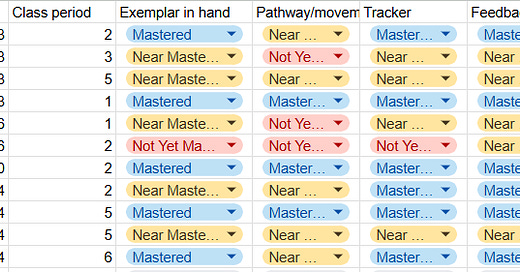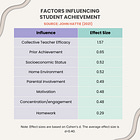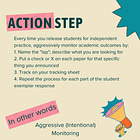Batch Coaching: A Smarter Way to Scale Growth
A consideration if you've got an especially novice staff
When coaching capacity is limited—but teacher needs are not—group coaching (also known as batch coaching) offers a high-impact, scalable approach to professional learning. Rather than stretching coaches thin across one-on-one cycles, group coaching targets shared needs, builds collective efficacy, and creates visible results in classrooms.
But batch coaching isn’t just a logistical workaround. When done well, it’s a research-backed lever for instructional improvement.
What Is Batch or Group Coaching?
Batch coaching is a structured, time-bound professional development model where a coach addresses a common instructional trend across a group of teachers. The goal isn’t just efficiency—it’s alignment, skill-building, and shared ownership.
What It’s Not:
A replacement for individualized coaching
A one-size-fits-all training
A passive sit-and-get PD
It’s a skill-specific, data-informed, action-oriented coaching cycle that capitalizes on group time to accelerate growth.
When to Use It
Batch coaching works best when:
Coaches face high teacher loads or limited capacity
Data reveals common trends across classrooms
A high-leverage skill needs widespread improvement
There’s existing shared time (e.g., PLCs, grade-level meetings)
New initiatives or instructional priorities need implementation at scale
How It Works: Four Key Steps
1. Train the Skill
Introduce a research-based practice in a whole-group or cross-grade training. Think of this as the “anchor” session to define terms, build initial understanding, and generate interest. PICK ONLY ONE SKILL.
Example: Launching aggressive monitoring by introducing check paths, trackers, and exemplar responses.
2. Conduct a Trend Analysis
Use observation data, student work, or informal walkthroughs to identify which elements of the skill are being under- or inconsistently implemented.
Example: Noticing that teachers understand the tracker, but aren’t using it to give feedback during instruction.
Here’s a blank one you can adapt.
3. Break It Down: Mini-PDs by Microskill
Group teachers into cohorts based on need, grade band, or readiness. Run short, targeted mini-PDs (e.g., 20–30 mins) focused on one microskill at a time. Include modeling, co-planning, PRACTICE, and reflection.
Example: One week focuses on “using exemplar responses,” the next on “strategically planning your check path.”
4. Follow-Up and Apply
Assign a task to implement the skill in the classroom. Then follow up with:
Individual feedback (via observation or video)
Student work analysis
Peer discussion and regroup
Group coaching should always connect to classroom impact—not just conceptual learning.
What Makes It Work: The Core Elements
📊 Evidence-Based Grouping
Why: Teachers are grouped by real instructional needs—not convenience.
How: Use:
Walkthrough trend data
Coaching logs
Student achievement gaps
Teacher self-assessments or surveys
Example: Grouping teachers who struggle with lesson pacing, and focusing on transitions and time-stamped lesson plans.
🎯 Focus on a High-Leverage Practice
Why: Depth beats breadth. A single, sticky skill can ripple across student achievement.
How: Choose practices supported by research, such as:
Independent practice or aggressive monitoring
School-wide discipline techniques like no-nonsense nurturer
Small-group instruction aligned to the science of reading
📣 Peer Learning and Shared Language
Why: Learning alongside peers increases buy-in, builds trust, and demystifies complex strategies.
How:
Model together, co-plan together, debrief together
Use common tools and shared rubrics
Normalize the messiness of implementation
Bonus: This also builds collective efficacy, a top factor in improving student achievement (Hattie, 2018).
🔁 Follow-Up and Individualization
Why: Without application, PD becomes shelfware.
How:
Use clear “look-fors” and commit to low-stakes follow-up
Offer asynchronous options (like Flip videos or lesson artifacts)
Provide opt-in coaching for those who want to go deeper
📍BONUS: Entry and Exit Criteria
Why: Group coaching is a launchpad, not a parking lot.
How: Set clear exit benchmarks (e.g., proficiency on a rubric or self-assessed comfort) so teachers can graduate to:
Individual coaching
Peer mentorship
Self-directed inquiry
Conditions for Success
Before launching batch coaching, assess the following:
Student Data: Where are students not meeting proficiency? Are there common gaps?
Teacher Skill & Tenure: Are there clusters of early-career teachers or those unfamiliar with the skill?
Culture: Is there a culture of trust and experimentation? Are teachers open to feedback?
Time Structures: Is there protected group learning time (PLCs, common planning)?
Coaching Capacity: Are 1:1 cycles possible for all, or do constraints demand more scalable models?
Other elements to consider:
Level of initiative fatigue
Alignment with school goals or instructional frameworks
Opportunities for peer modeling or lab classrooms
In Practice: Group Coaching for Aggressive Monitoring
Let’s walk through an example.
Introduce the skill of aggressive monitoring to all staff at a back-to-school PD
Trend-Based Grouping: Teachers are recommended to attend specific sessions based on walkthrough data (optionally, teachers can self-select).
Mini PD Cycle:
Session 1: Introduction to aggressive monitoring and exemplar answers
Session 2: Planning check paths and student trackers
Session 3: Giving real-time feedback based on student responses
Shared Practice: Teachers co-plan using shared materials, align on look-fors, and discuss common pitfalls.
Follow-Up: Coach observes implementation and debriefs with each teacher. The group reconvenes for reflection and goal-setting.
Final Word
Batch coaching is more than a workaround for limited time—it’s a smart, strategic method for building aligned, skillful, and confident teachers. But remember to read the room and get feedback early and often. It can be vulnerable for folks. When grounded in evidence, focused on practice, and designed with real application in mind, group coaching can transform PD from a compliance activity into a collaborative, empowering force.









